Belkin F9K1001V1 User Manual

User Manual
8820-00773 Rev. A00
Table Of Contents
Getting Started . . . . . . . . . . . . . . . . . . . . . . . . . . . . . |
1. . . . . . . |
Troubleshooting,. . . . . . . |
Support, and Warranty . . . . . . . . . . . . . |
26. . . . . . |
What’s in the Box . . . . . . . . . . . . . . . . . . . . . . 1 Initial Setup . . . . . . . . . . . . . . . . . . . . . . . . . 1 Advanced Tools & Settings . . . . . . . . . . . . . . . . . . 6 The Belkin Router Manager . . . . . . . . . . . . . . . . . . 7 Manual Setup Using Your Browser . . . . . . . . . . . . . . . 8 Adding Computers to Your Network . . . . . . . . . . . . . . . 9
Troubleshooting . . . . . . . . . . . . . . . . . . . . . . 26 Technical Support . . . . . . . . . . . . . . . . . . . . . . 33 Belkin International, Inc., Limited 2-Year Product Warranty . . . . 34
Regulatory Information . . . . . . . . . . . . . . . . . . . . . . . .37. . . . . .
FCC Statement . . . . . . . . . . . . . . . . . . . . . . . 37
Getting to Know Your Router . . . . . . . . . . . . . . . . . . . . 11. . . . . . . .CE. .Statement . . . . . . . . . . . . . . . . . . . . . . . 38
Front Panel . . . . . . . . . . . . . . . . . . . . . . . . . 11
Back Panel . . . . . . . . . . . . . . . . . . . . . . . . . 12
Technical Details . . . . . . . . . . . . . . . . . . . . . . . . . . . |
13. . . . . . . . . . . . . |
Technical Features . . . . . . . . . . . . . . . . . . . . . 13 |
|
System Requirements . . . . . . . . . . . . . . . . . . . . 14 |
|
Using Your Router . . . . . . . . . . . . . . . . . . . . . . . . . . |
15. . . . . . . . . . . . . |
Enabling Auto Update on Your Belkin Router . . . . . . . . . . 15 Updating Your Router via Your System Tray
(Windows) or Menu Bar (Mac) . . . . . . . . . . . . . . . . 17 Updating the Router’s Firmware via the Web Interface . . . . . . 18 Resetting the Router . . . . . . . . . . . . . . . . . . . . . 22 Restoring Your Router to Factory Defaults . . . . . . . . . . . 22 Restoring the Router to Default Settings Using the Web Interface . 23

Getting Started
What’s in the Box |
Initial Setup |
N150 Wireless Router
Ethernet cable (attached to router) Power supply (attached to router)
Network information card (attached to router) Belkin Setup CD with User Manual
Where to Place Your Router
For the best results, place the Router next to your modem in an open location away from large metal objects and magnets such as those found in speakers. Raising the Router above floor level can improve the strength of your wireless signal.
1

Getting Started
How to Set It Up
2

Getting Started
1..Connect your Router’s Ethernet cable to your modem’s Ethernet port (on the back of your modem). This port might be labeled differently on your particular modem. If you are adding a Router for the first time, this port may be connected to your computer by an Ethernet cable. It is OK to disconnect your computer and plug the Router into the modem instead.
2..Plug the Router’s power supply into a wall outlet.
3..Put the CD into your computer. If the CD doesn’t open automatically, please browse to your CD drive and double-click on the Belkin Setup CD icon.
Setup
4.. Click the Setup icon on the CD menu.
3
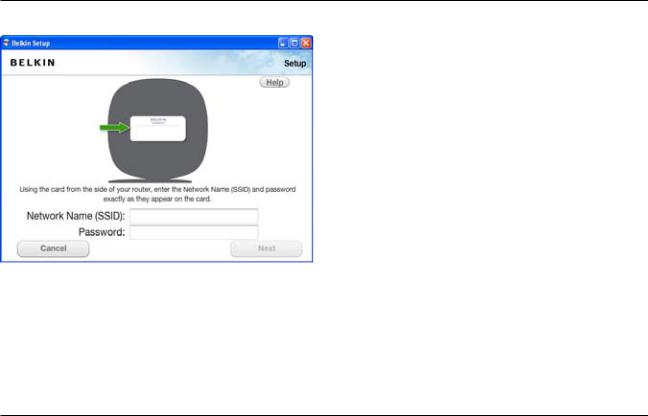
Getting Started
5..After a brief installation, the setup software will ask you for the network name and password from the network information card that is attached to your Router. Store the card under the base of your Router for future reference.
4
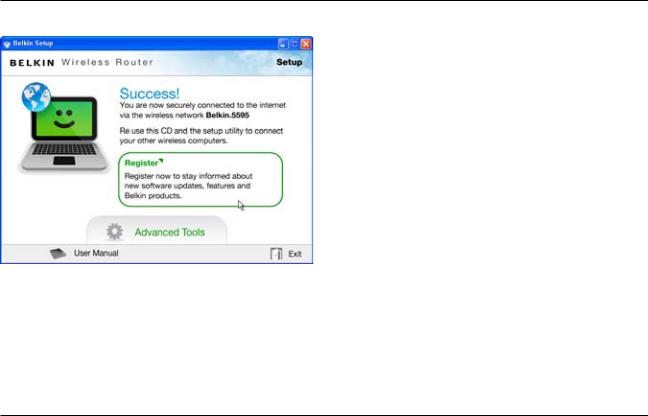
Getting Started
6..A progress screen will appear while additional software is installed. This may take a few minutes to complete. Once finished, a “Success” message will appear indicating that you are connected to the Internet via your new Belkin Router.
During setup you may be asked for additional information..
You may need to enter a username and password provided by your ISP. This username and password is likely to be found on materials that came from your ISP when you signed up for service. If necessary, you may need to contact your ISP to retrieve your username and password.
If you have a static IP address, you may need to enter additional information also provided by your ISP.
If your computer doesn’t have a wireless adapter, or the setup software is unable to control it, you may be asked to connect your computer to the Router with a network cable.
5
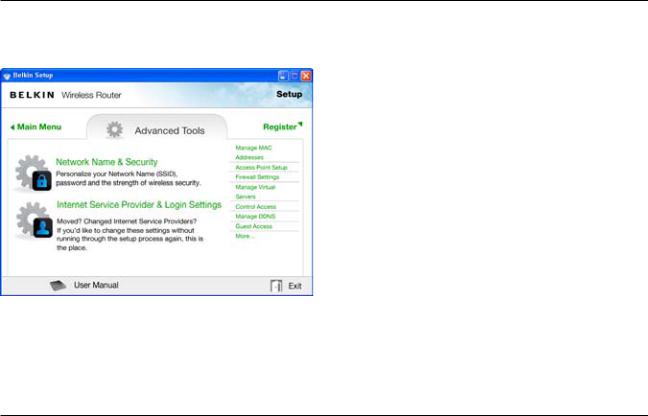
Getting Started
Advanced Tools & Settings
After the initial setup is complete, you have the option to change settings like your network name, security type, and password. To make these changes and others, click on the Advanced Tools icon at the CD Setup menu and select one of the following settings that you would like to change:
Network Name & Security – Personalize your network name (SSID), password, and strength of wireless security.
Internet Service Provider & Login Settings – Have you moved or changed Internet Service Providers?
If you’d like to change these settings without running through the setup process again, this is the place.
6
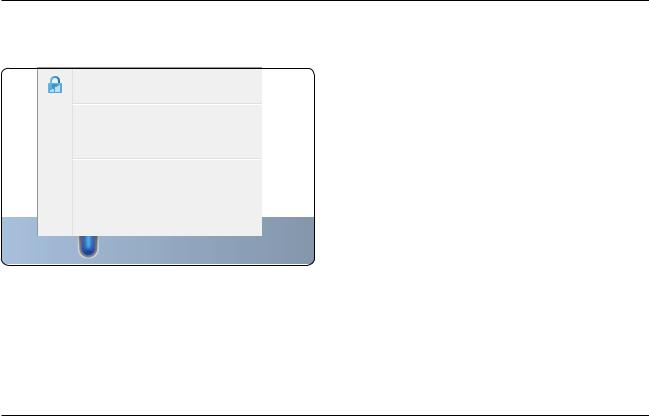
Getting Started
The Belkin Router Manager
belkin.310
Router Settings
User Manual
Check for Updates
Options
Exit
The Belkin Router Manager appears in your system tray (Windows) or menu bar (Mac). Its icon indicates the current status of your Router and also allows you to access your Router’s settings to make changes. It also provides quick access to software that came bundled with your Router.
To access the Router settings, click on the icon and select from the menu that appears.
The status of your Router is shown by the Belkin Router Manager icon, which closely mimics the light on the front of the Router.
Blue: You are connected to your Belkin Router and it is connected to the Internet.
Amber: You are connected to your Belkin Router, but it is not connected to the Internet.
7
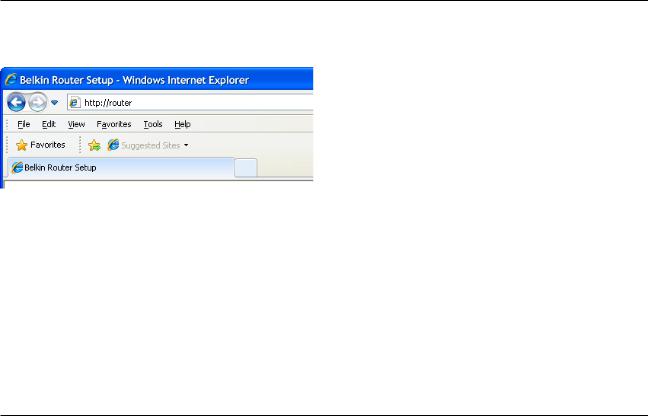
Getting Started
Manual Setup Using Your Browser
In your browser, type “http://router” (you do not need to type in anything else such as “www”). Then press the Enter key. If
you’re still having trouble running the manual setup option, type “192.168.2.1” in your browser (you do not need to type in anything else such as “http://” or “www”). Then press the Enter key.
8

Getting Started
Adding Computers to Your Network
Wireless devices such as computers, network printers, and gaming systems can connect to your Router with a few simple steps.
Using the CD
1..Put the Setup CD into your computer. If the CD doesn’t open automatically, browse to your CD drive and open the Belkin Setup CD icon.
2..Click the Setup icon on the CD menu.
3..After a brief installation, the setup software will ask you for the network name and password from the network information card that came with your Router. This card is most likely now located underneath the foot of your Router in the provided card slot.
4..A progress screen will appear while additional software is installed. This may take a few minutes to complete. Once finished, a “Success” message will appear indicating that you are connected to the Internet via your new Belkin Router.
Note: The setup software runs only on
Windows and Mac OS X systems.
9

Getting Started
Manually
If you choose not to use the included Setup CD for adding additional computers or wireless devices, you can manually add these items to your network.
1..Locate the wireless-network-connections option on your computer or wireless device.
2..Select your Belkin Router from the list of available networks. You can identify your Belkin Router by locating the network name (SSID) from the card located underneath the foot of your Router.
3..Enter your network password (located on your network information card).
Your wireless device will take a few moments to connect to your network. If the connection is not made the first time, try this process again. If you still have difficulty connecting to your network after trying this process a few times, see the “Troubleshooting” section in this manual for help with connecting to your network.
Note: In some cases you may be prompted to select the security type. It is printed on the card for your convenience.
Using the WPS Button
1..Start WPS Push Button Connection (WPS PBC) on your computer or other Wi-Fi device that you would like to connect wirelessly to your Router. Often there will be a button for this purpose in software that came with the device, or a physical “WPS,” “PBC,” or “Security” button on the device itself.
2..Within two minutes, press the WPS button on your Router.
The WPS light (small light above WPS button) will blink blue while it listens for your Wi-Fi device. Once a connection is established, the light will turn blue and then go out. If a connection is not established, the light will blink amber. You may repeat the process to try again.
You can repeat this process for each WPS-enabled device you’d like to add to your network.
10

Getting to Know Your Router
Front Panel
A
B
A) Router Status Light
Your Router’s status is shown by the light on the front.
Off: The Router is not plugged into a power source. Blinking Blue: The Router is starting up.
Solid Blue: The Router is connected to the Internet.
Blinking Amber: The Router can’t detect the modem. Either the modem is off, is not plugged into the Router, or is unresponsive.
B) Wi-Fi Protected Setup (WPS) Light and Button
The WPS button on the front of your Router can be used to help establish a secure connection between your Router and other WPS-enabled Wi-Fi devices such as computers. To use the WPS feature on your Router, see “Getting Started > Adding Computers to Your Network > Using the WPS Button”.
The small light near the WPS button shows what is happening while you are using WPS to establish a connection.
Off: Idle
Blinking Blue: The Router is listening for a WPSenabled computer or other device.
Solid Blue: The Router has made a secure connection with the computer or other device.
Amber: A connection was not created.
11
